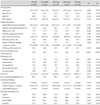1. Kinoshita N, Imai K, Kinjo K, Naka M. Longitudinal study of acute myocardial infarction in the southeast Osaka district from 1988 to 2002. Circ J. 2005. 69:1170–1175.
2. Hjalmarson A, Gilpin EA, Nicod P, et al. Differing circadian patterns of symptom onset in subgroups of patients with acute myocardial infarction. Circulation. 1989. 80:267–275.
3. Kim KS, Song YS, Hur SH, et al. Circadian variation in acute myocardial infarction. Korean Circ J. 1993. 23:173–183.
4. López F, Lee KW, Marín F, et al. Are there ethnic differences in the circadian variation in onset of acute myocardial infarction?: a comparison of 3 ethnic groups in Birmingham, UK and Alicante, Spain. Int J Cardiol. 2005. 100:151–154.
5. D'Negri CE, Nicola-Siri L, Vigo DE, Girotti LA, Cardinali DP. Circadian analysis of myocardial infarction incidence in an Argentine and Uruguayan population. BMC Cardiovasc Disord. 2006. 6:1.
6. Rana JS, Mukamal KJ, Morgan JP, Muller JE, Mittleman MA. Circadian variation in the onset of myocardial infarction: effect of duration of diabetes. Diabetes. 2003. 52:1464–1468.
7. Kinjo K, Sato H, Sato H, et al. Circadian variation of the onset of acute myocardial infarction in the Osaka area, 1998-1999: characterization of morning and nighttime peaks. Jpn Circ J. 2001. 65:617–620.
8. Muller JE, Kaufmann PG, Luepker RV, Weisfeldt ML, Deedwania PC, Willerson JT. Mechanisms precipitating acute cardiac events: review and recommendations of an NHLBI workshop. National Heart, Lung, and Blood Institute. Circulation. 1997. 96:3233–3239.
9. Bhalla A, Sachdev A, Lehl SS, Singh R, D'Cruz S. Ageing and circadian variation in cardiovascular events. Singapore Med J. 2006. 47:305–308.
10. Willich SN. Circadian variation and triggering of cardiovascular events. Vasc Med. 1999. 4:41–49.
11. Sari I, Davutoglu V, Erer B, et al. Analysis of circadian variation of acute myocardial infarction: afternoon predominance in Turkish population. Int J Clin Pract. 2009. 63:82–86.
12. Henriques JP, Haasdijk AP, Zijlstra F. Outcome of primary angioplasty for acute myocardial infarction during routine duty hours versus during off-hours. J Am Coll Cardiol. 2003. 41:2138–2142.
13. Magid DJ, Wang Y, Herrin J, et al. Relationship between time of day, day of week, timeliness of reperfusion, and in-hospital mortality for patients with acute ST-segment elevation myocardial infarction. JAMA. 2005. 294:803–812.
14. Mukamal KJ, Muller JE, Maclure M, Sherwood JB, Mittleman MA. Increased risk of congestive heart failure among infarctions with nighttime onset. Am Heart J. 2000. 140:438–442.
15. Park SR, Kang YR, Seo MK, et al. Clinical predictors of incomplete ST-segment resolution in the patients with acute ST segment elevation myocardial infarction. Korean Circ J. 2009. 39:310–316.
16. Lee CH, Joo SJ, Park DS, et al. Remodeling and changes of systolic and diastolic functions of left ventricle after acute myocardial infarction: comparison according to killip class at admission. Korean Circ J. 1998. 28:1727–1739.
17. Al Suwaidi J, Reddan DN, Williams K, et al. Prognostic implications of abnormalities in renal function in patients with acute coronary syndromes. Circulation. 2002. 106:974–980.
18. Naidu SS, Selzer F, Jacobs A, et al. Renal insufficiency is an independent predictor of mortality after percutaneous coronary intervention. Am J Cardiol. 2003. 92:1160–1164.
19. Cannon CP, Gibson CM, Lambrew CT, et al. Relationship of symptom-onset-to-balloon time and door-to-balloon time with mortality in patients undergoing angioplasty for acute myocardial infarction. JAMA. 2000. 283:2941–2947.
20. Magid DJ, Calonge BN, Rumsfeld JS, et al. Relation between hospital primary angioplasty volume and mortality for patients with acute MI treated with primary angioplasty vs thrombolytic therapy. JAMA. 2000. 284:3131–3138.
21. Canto JG, Every NR, Magid DJ, et al. The volume of primary angioplasty procedures and survival after acute myocardial infarction. National Registry of Myocardial Infarction 2 Investigators. N Engl J Med. 2000. 342:1573–1580.
22. Vakili BA, Kaplan R, Brown DL. Volume-outcome relation for physicians and hospitals performing angioplasty for acute myocardial infarction in New York state. Circulation. 2001. 104:2171–2176.
23. Assali AR, Brosh D, Vaknin-Assa H, et al. The impact of circadian variation on outcomes in emergency acute anterior myocardial infarction percutaneous coronary intervention. Catheter Cardiovasc Interv. 2006. 67:221–226.
24. Dominguez-Rodriguez A, Garcia-Gonzalez M, Abreu-Gonzalez P. Outcome of primary angioplasty for ST-segment elevation myocardial infarction during routine duty hours versus during off-hours: results of a single-center in Spain. Int J Cardiol. 2007. 119:227–229.
25. Berger PB, Ellis SG, Holmes DR Jr, et al. Relationship between delay in performing direct coronary angioplasty and early clinical outcome in patients with acute myocardial infarction: results from the Global Use of Strategies to Open Occluded Arteries in Acute Coronary Syndromes (GUSTO-IIb) Trial. Circulation. 1999. 100:14–20.










 PDF
PDF ePub
ePub Citation
Citation Print
Print



 XML Download
XML Download